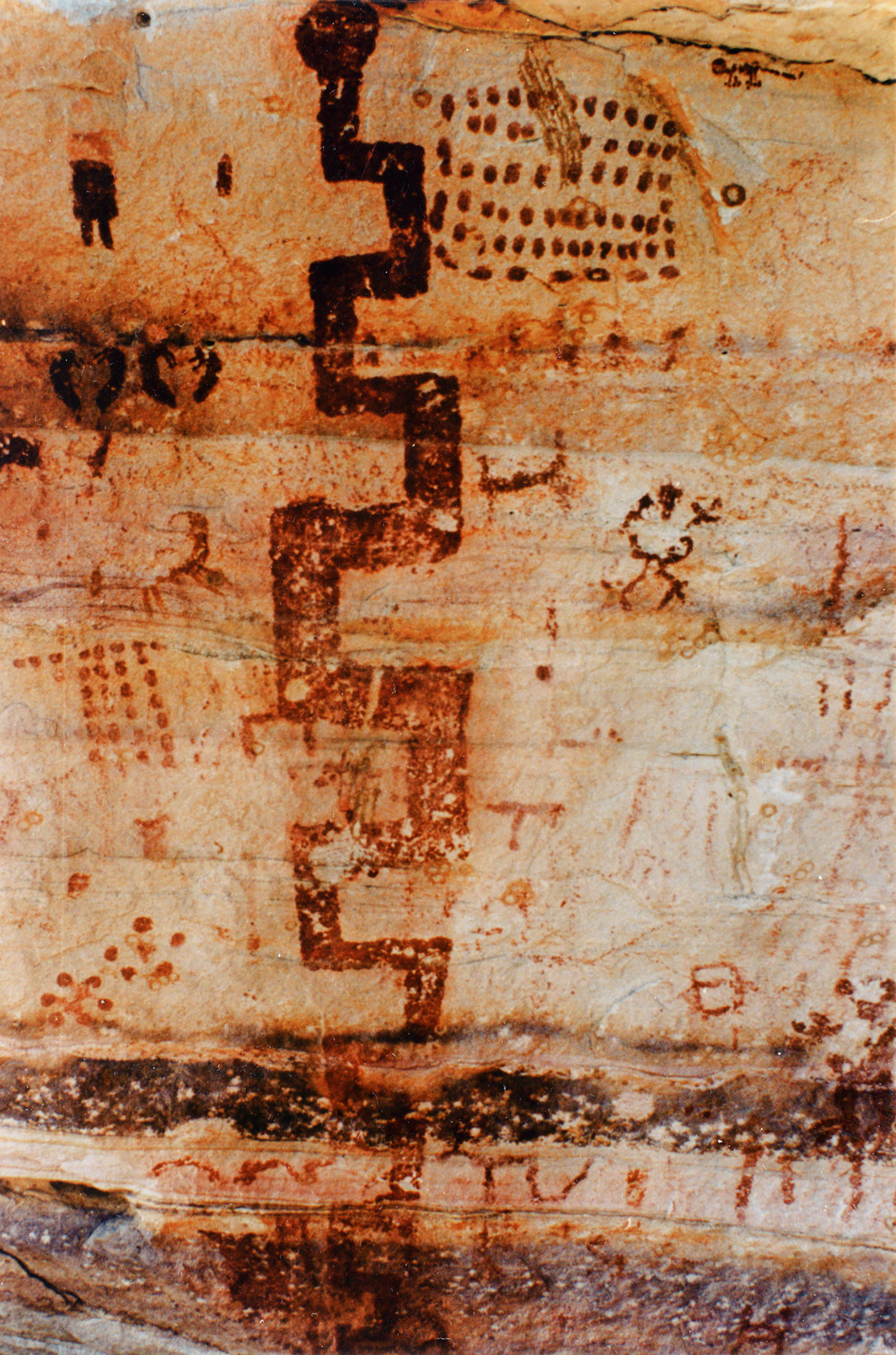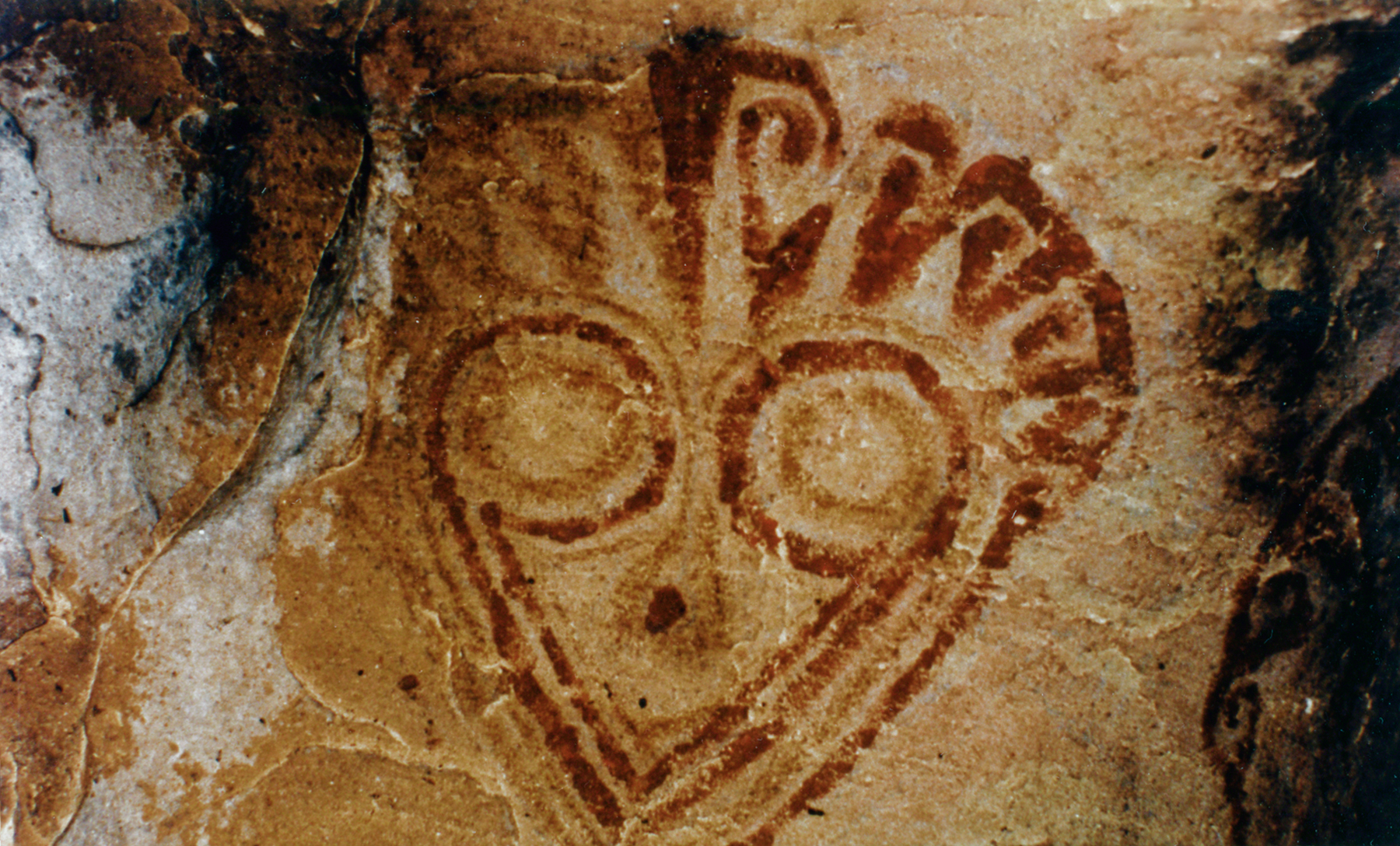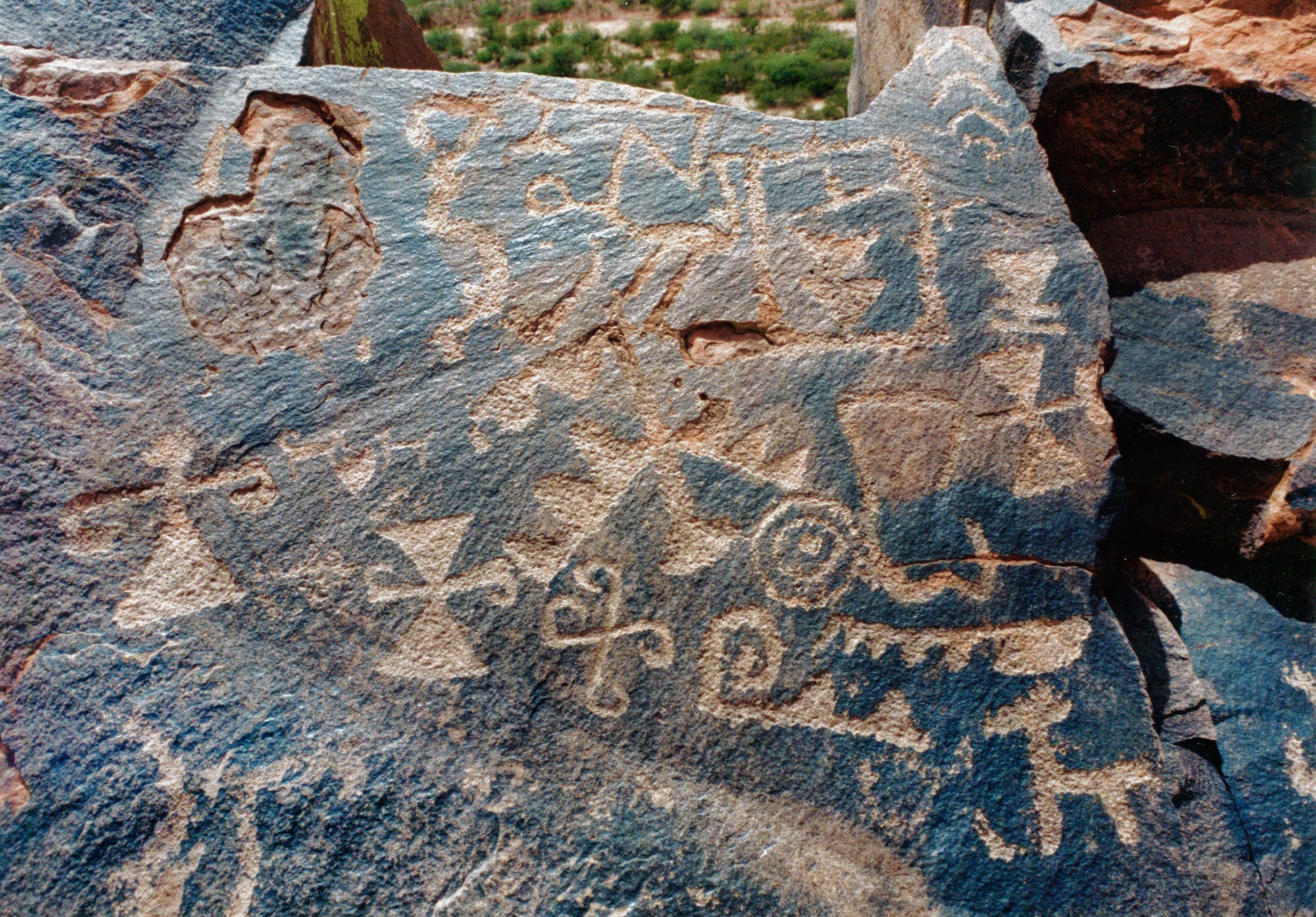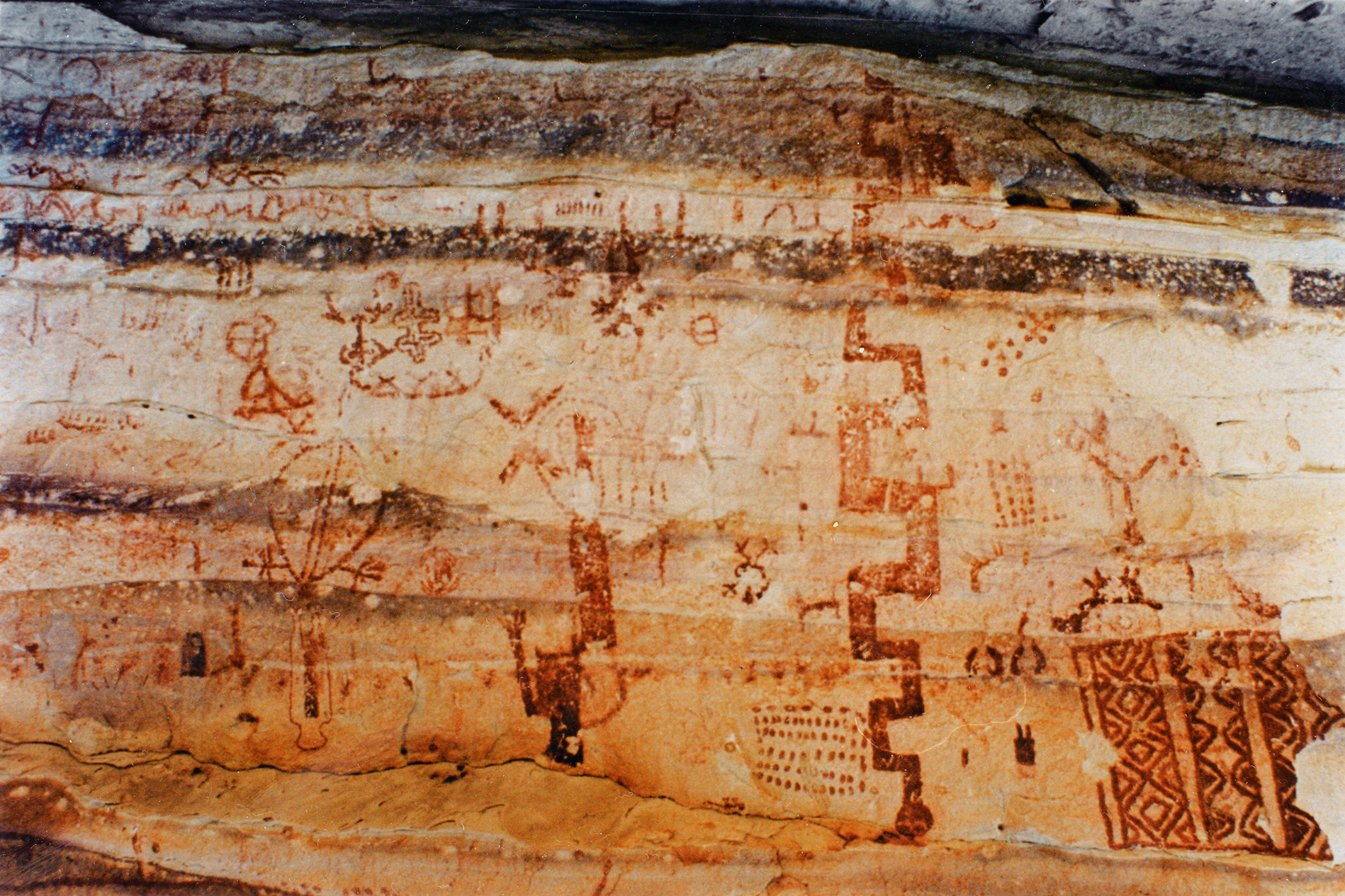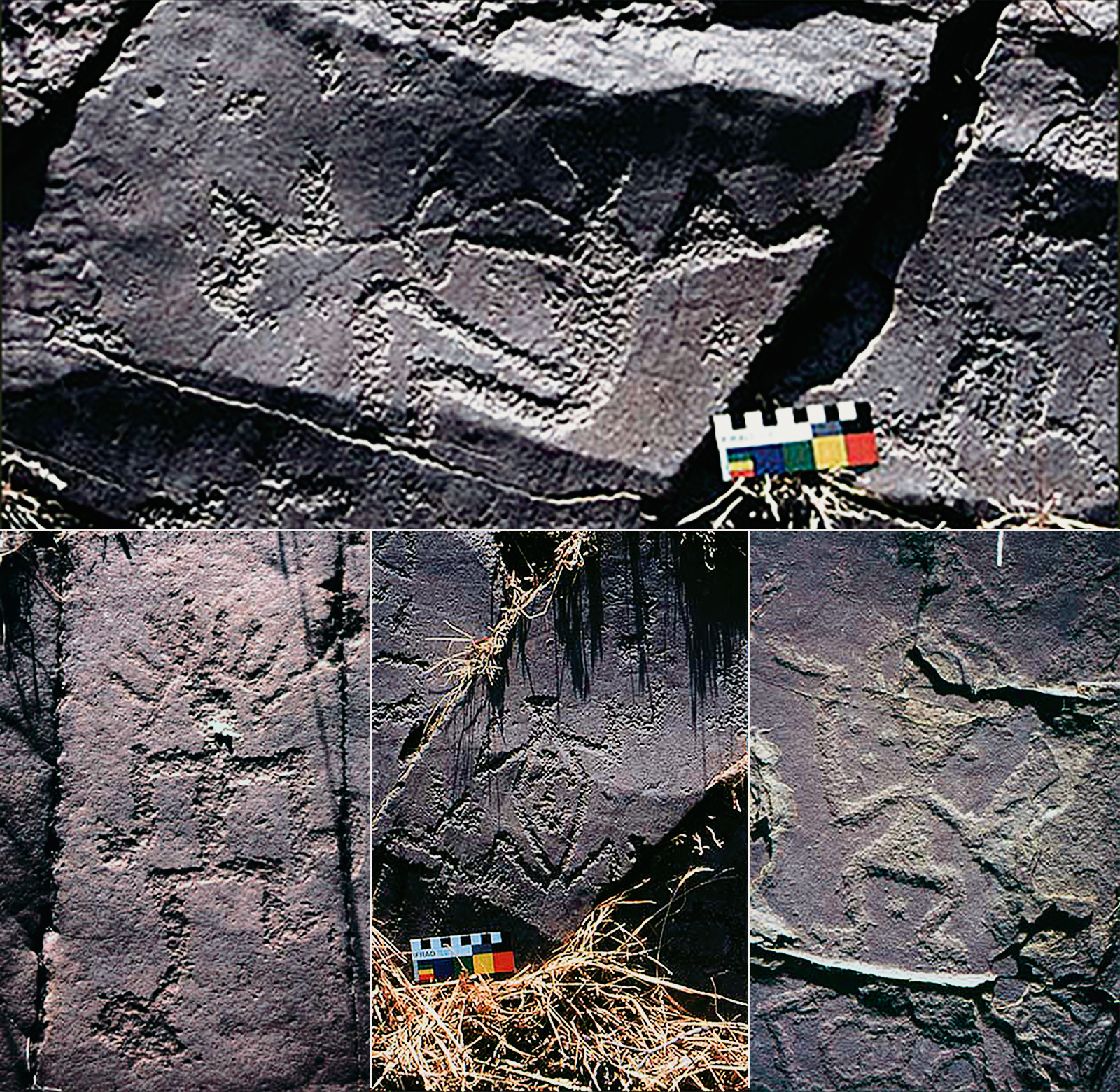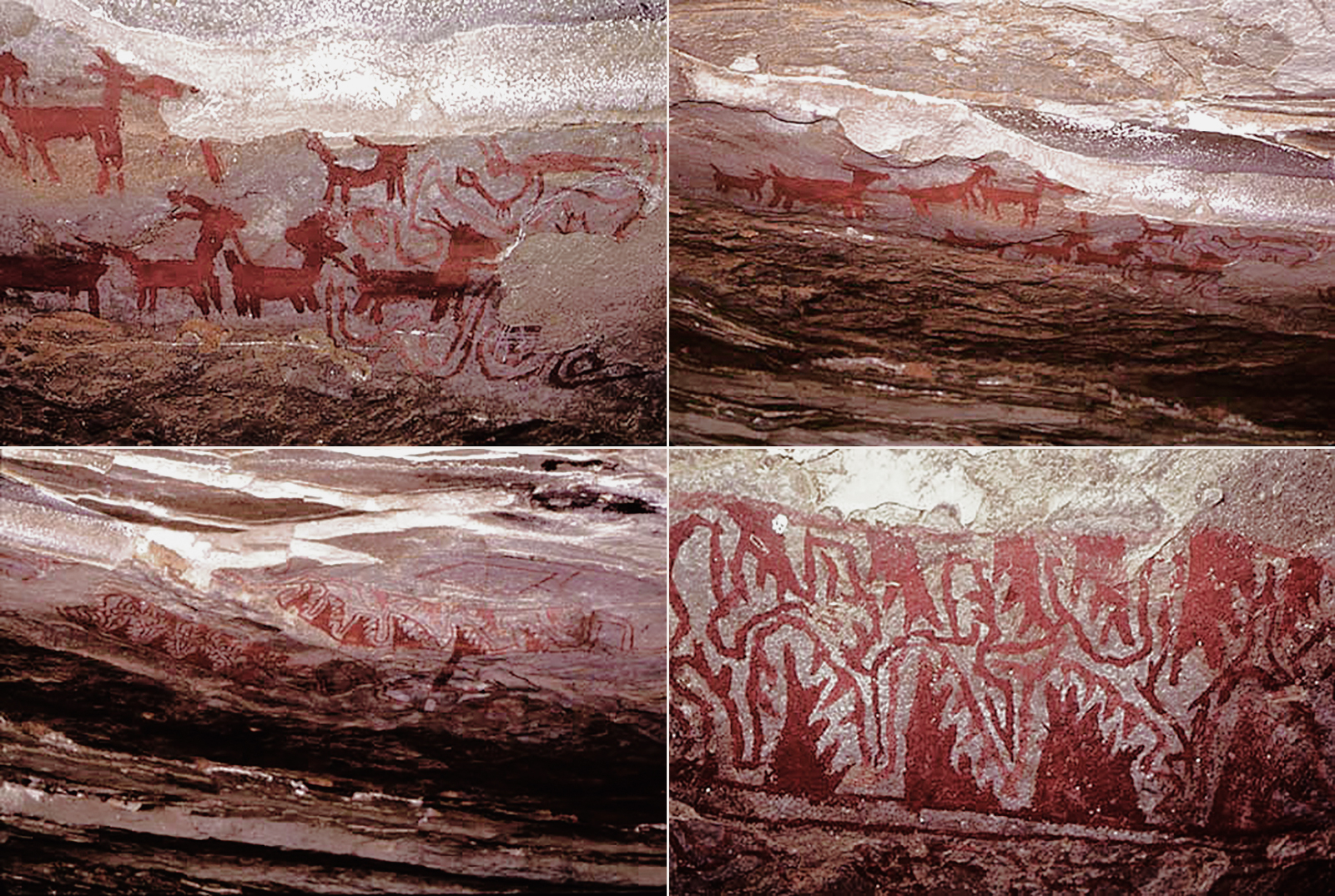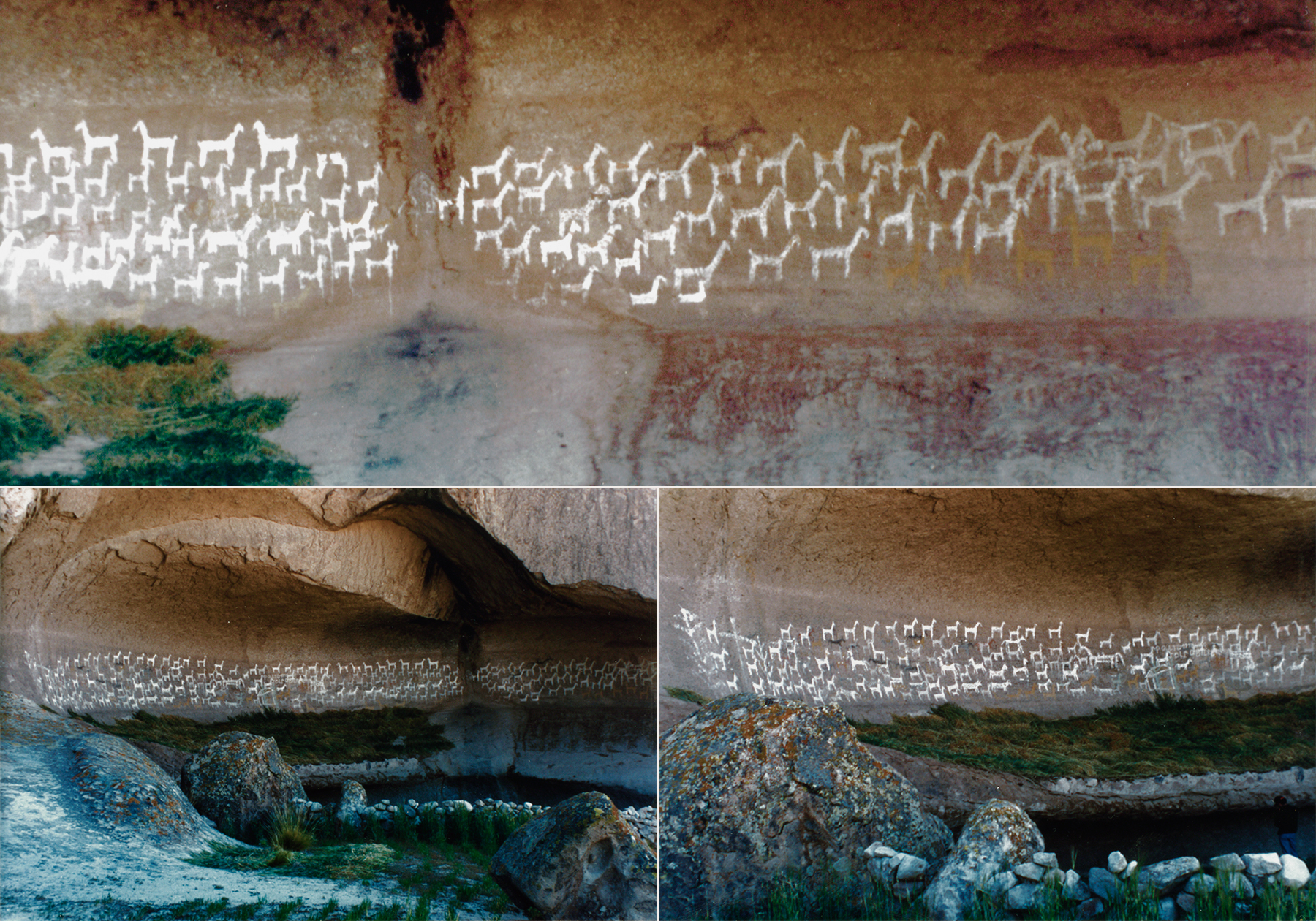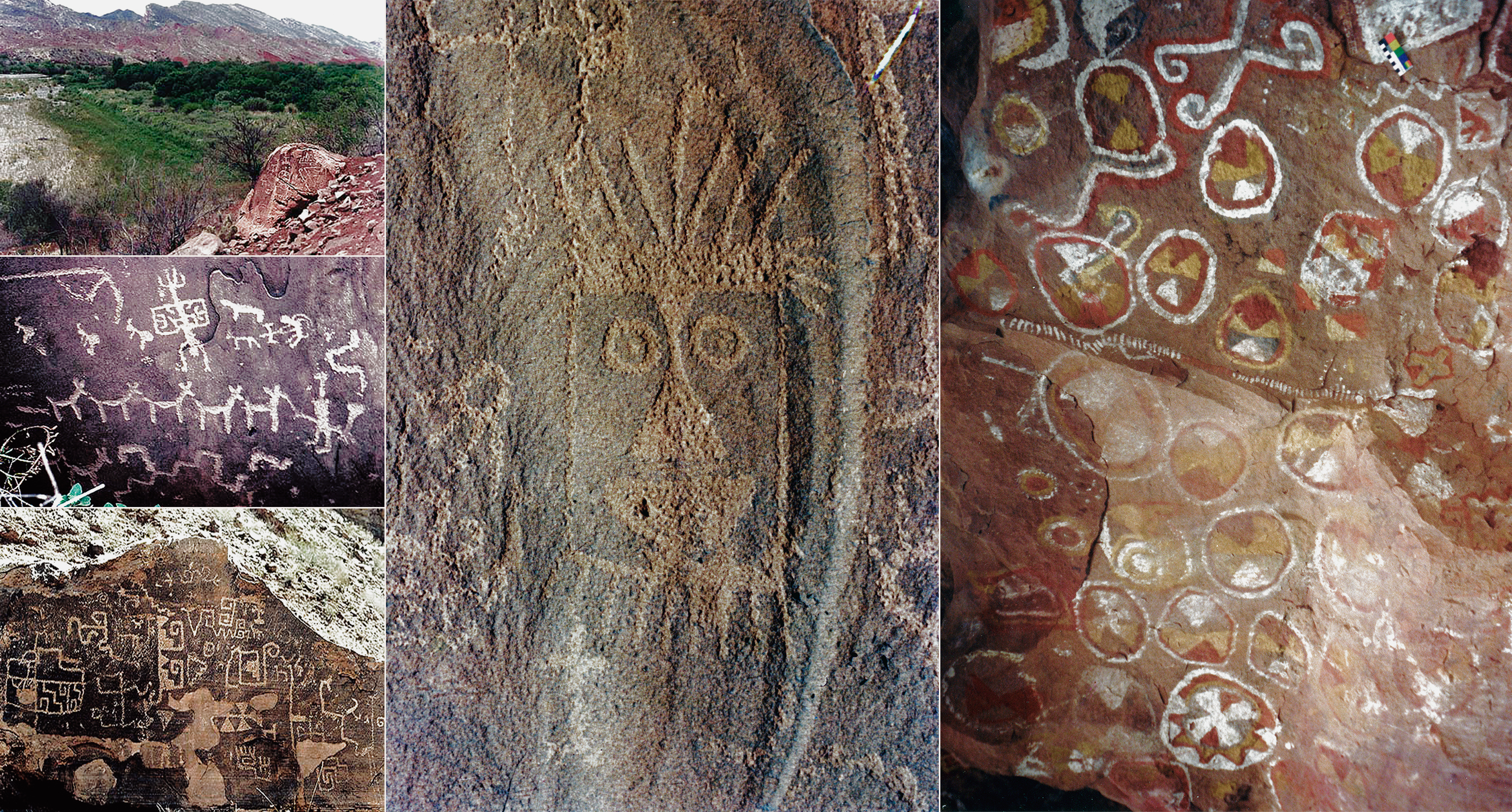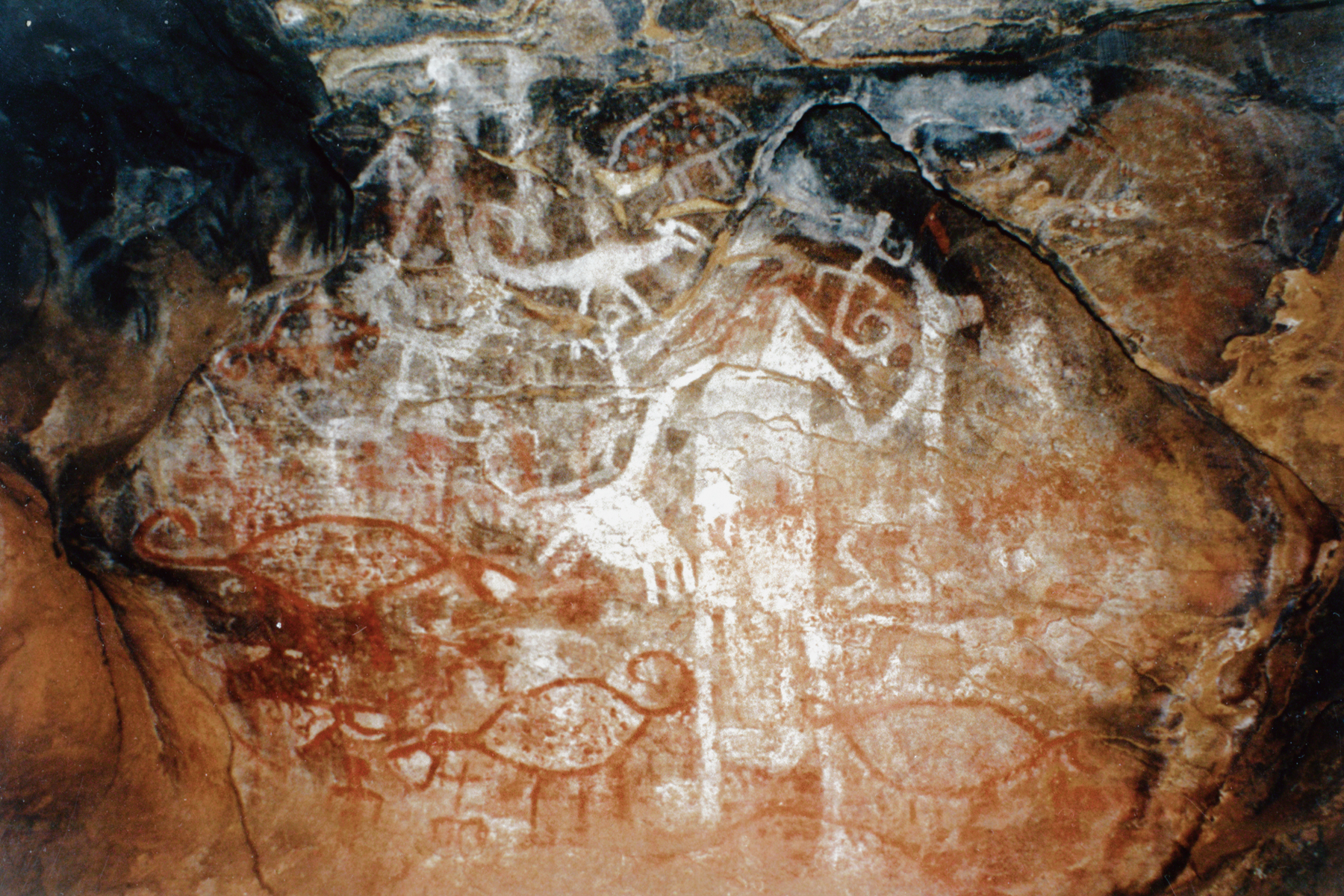



According to preliminary investigations carried out by SIARB, the rock art spans at least several millenia. The earliest rock art, which seems to date back to the Paleo-Indian period, may consist of painted hunting scenes with groups of camelids in lively movement [possibly guanacos] and diminutive human figures, similar to representations found in Peru and Chile . In various sites ancient hand imprints occur, but it is not known whether they belong to the same age as those of the caves of Patagonia [7,000 B.C.]. In many parts of Bolivia, cupules or cup-marks occur, some of which may belong to the earliest rock carvings.
This gallery in the South American Rock Art Archive features some of the best examples of Bolivian rock art and some of the latest discoveries made.
Rock art research in Bolivia is still in its initial stages, if we consider the lack of an exact chronology and the lack of intensive investigations in many regions. There is very limited state funding for investigations of the country's rich archaeological heritage, so it is left to a private scientific institution, Sociedad de Investigacion del Arte Rupestre de Bolivia (SIARB) to register, record and publish rock art sites. SIARB was founded in 1987. The society numbers some 150 members in Bolivia as well as world-wide.
It publishes a yearly journal, Boletin, and a series called Contributions to South American Rock Art Studies.
Surveys of rock art regions by SIARB have already registered approximately 1,000 rock art sites all over Bolivia, though mainly in the highlands (altiplano) and valleys. So far, few sites have been found in the tropical Amazon lowlands. Apart from rock paintings and engravings, SIARB investigators have studied cupules in several departments: Tarija, Cochabamba, and La Paz.
Concentrations of rock art sites occur in the following regions: the Dept. of Tarija and neigbouring regions, such as the San Juan de Oro river and Cinti in the south of the Dept. of Chuquisaca; the west of Chuquisaca and east of Potosí; central; the drainage area of Mizque river, Cochabamba, and neighbouring regions in west Santa Cruz; San Jose de Chiquitos highlands in central Santa Cruz; Santiago de Chiquitos highlands, Santa Cruz; east Oruro and west Cochabamba; north Oruro; lake Titicaca basin.
The rock art of Bolivia forms part of the Bradshaw Foundation - South American Rock Art Archive. The Bradshaw Foundation would like to thank Matthias Strecker and the Sociedad de Investigacion del Arte Rupestre de Bolivia (SIARB) for helping assemble material for the Boliva section of this archive.
In 2000 Matthias Strecker, Editor of the SIARB Annual Bulletin came to England to discuss with John Robinson of the Bradshaw Foundation Geneva the project to build a viewing platform at the Calacala site.
Construction of the wooden walkway has been completed it has been designed to reach right across the whole length of the Calacala Rock Art gallery. As can be seen from the photographs below the walkway provides an extensive viewing platform of the paintings and engravings, and at the same time gives protection to the gallery as it prevents visitors climbing on the rock. Later, a vistors' centre and museum will be constructed to inform tourists not only about rock art, but also on the role of camelids (llamas, alpacas and vicuñas) in traditional Andean societies.
The village of Calacala (place of many rocks) is situated 13 miles (21 km) southeast of the city of Oruro at an altitude of nearly 10,000 feet above sea level. Large parts of the surrounding region are used as pasture for the 500 llamas owned by the 70 families that live in and around the village. Once a year, on September 14, numerous pilgrams arrive at Calacala from other indigenous villages and the city of Oruro for the festivity of Exaltación de Santa Cruz, popularly known as the festivity of Lord of the Lakes.
The principal rock art site (a small cave and a rock shelter) is situated to the southeast of the village, at a distance of 2 km, and at an altitude of 4.050 m. There are numerous paintings in different shades of red colour, white and black, and engravings, mostly representing llamas, with a few human figures, and some felines. Another feature of the rock art are cupholes or "cupules" carved on vertical or horizontal surfaces. The art clearly refers to pastoral life showing llamas accompanied by its pastors, sometimes the human figures are connected to the animals by a rope. One of the panels is dominated by a white llama figure (height: 60 cm), the favourite sacrificial animal in indigenous rites until today.
In 1970, this outstanding site was declared a National Monument by the Bolivian state. In 1976 the National Archaeological Institute fenced in an area of 23 x 60m protecting the decorated cave and rock shelter. Since then the National Anthropological Museum in Oruro has been responsible for maintaining this small archaeological park. A resident of Calacala was appointed guardian and accompanies visitors to the site. The Bolivian Rock Art Research Society SIARB published an article on rock art at Calacala in its Boletin 15 (2001).
This rock shelter is situated at the border of departments of Cochabamba and Santa Cruz. It displays a great variety of paintings, probably all belonging to a prehispanic period when ceramics and textiles flourished. One of the designs seems to depict a textile. Most figures were painted in dark red, others in different shades of red, pink, white and black.
The principal panel is dominated by a large stylized serpent (length: 1,80 m). Anthropomorphs, figures of cuadrupeds, as well as numerous geometric or abstract designs are represented. Some of the rock art of El Buey has striking similarities to the rock art paintings and petroglyphs of Campeche Island.
The rock art of Campeche, officially the Free and Sovereign State of Campeche (Spanish: Estado Libre y Soberano de Campeche), is one of the 31 states which make up the 32 Federal Entities of Mexico. Located in southeast Mexico.
At this site numerous paintings and a few engravings reveal the influence of the Spanish culture on traditional indigenous concepts. Numerous religious scenes are depicted including pilgrims walking on pathways to churches and folkloric dances.
The Orozas rock art petroglyph site is noteworthy for its rock art carvings which picture humans and animals (monkeys, birds). Some zoomorphic representations are shown with a smaller animal in the interior.
The Palacios rock art site is one of the few cases in Bolivia, where a small cave or rock shelter served as ancient cemetery and rock art site. Among the rock art paintings, a long abstract motif with interior design stands out which has been interpreted by the archaeologist Dick Edgar Ibarra Grasso as "winged serpent".
A large boulder at Peña Colorada in Bolivia is covered by numerous deep cut engravings showing abstract patterns, such as circles, crosses, spirals, etc., as well as a few stylized human and animals figures.

The rock art site of Poopó features rock art petroglyph engravings, representing wild animals, such as rheas, sometimes associated with hunters who use slings, and dot patterns; as well as a few domesticated camelids (probably llamas), one of which is led by its pastor.
Bolivian rock art, largely unknown even to students of the prehistory of the country, comprises a wealth of petroglyphs (rock carvings) and rock paintings in small caves and rock shelters, on vertical cliffs or on large boulders.
The impressive rock art shelter of Pultuma displays a long row of llama figures, mostly painted in white (average length: 50-60 cm, however they also include two especially large figures of more than a meter length). In recent times, horseriders and the pictures of a house and of the Sajama mountain have been added.
The valley and mountain range near San Juan del Oro river (in the frontier of departments of Potosí, Chuquisaca and Tarija) is an ancient traffic route traditionally used by llama caravans transporting goods between the highlands and the lower tropical regions. Even today, a few "llameros" (leaders of llama caravans) keep up this tradition though they are replaced more and more by truck drivers. The traditional route is frequently marked by engraved rocks with the llama as one of the most common motifs, sometimes lined up for transportation of goods, other animals, and human figures, apart from faces, geometric designs, feet and hands. Elaborate multi-coloured rock paintings also occur in the same region. A variety of bright colours have been used to depict large abstract designs, sometimes animal and human rock art figures.
The Bradshaw Foundation funded an expedition to Bolivia to enable new photographs to be taken by Carlos Methfessel in 2001. While in the region he discovered another cave depicting human figures clad in a sort of "uncus", a long indigenous garment accomapnied by serpents and other geometrical symbols.
Vallegrande in west of Dept. Santa Cruz belongs to the Andean highlands. Numerous rock art sites have been registered with a great variety of paintings and engravings that span at least several millenia. Two sites are presented here: A small cave with paintings and engravings executed in different periods.
The oldest representations are more than 20 negative hand stencils. In later times a large stylized human figure was painted in white holding a staff and another object (height: 1,13 m). Some animals were partly painted on top of this anthropomorph, in red and white. Apparently, a few abstract motifs in yellow and red represent the next phase, and finally there are white paintings belonging to the Colonial period, including a human figure holding up a cross, apparently scaring away another anthropomorph pictured in a frog-like fashion.
Another small cave in Vallegrande, features two magnificent mask-like designs, one of which was chosen as logo of the Bolivian Rock Art Society (SIARB). It is estimated to date to about 1000 A.D.
→ Subscribe free to the Bradshaw Foundation YouTube Channel
→ South America Rock Art Archive
→ Rock Art of Serra da Capivara
→ Rock Art of Pedra Furada
→ World Heritage Site of Cueva de las Manos (The Cave of the Hands)
→ Rock Art of Bolivia
→ The Rock Art of Santa Catarina
→ The Checta Petroplyphs - Peru
→ Bradshaw Foundation
→ Rock Art Network
